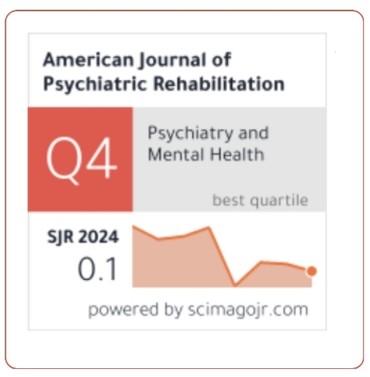Digital Identities: Adolescents’ Construction of Identity Influenced by Modern Trends of Social Media
DOI:
https://doi.org/10.69980/ajpr.v28i1.74Keywords:
Adolescents; Social; Media; Self; IdentityAbstract
The vast majority of researchers have looked into how people use social media, but they have ignored the impact it has on people's ability to regulate their sense of identity and connectedness to others, and their perceptions. The rapid rise in the use of social media is something that, depending on one's perspective, either poses a challenge or presents an opportunity for today's younger generations. With 400 adolescents in India, the study here uses the Aspects of Identity (AIQ – IV) questionnaire to understand the impact caused by social media usage. Multiple linear regression suggests the significant role of social media usage among the adolescents on the creation of four aspects of identity. The study provides implications based on the results.
References
1. Allen, K. A., Ryan, T., Gray, D. L., McInerney, D. M., & Waters, L. (2014). Social media use and social connectedness in adolescents: The positives and the potential pitfalls. The Educational and Developmental Psychologist, 31(1), 18-31.
2. Branje, S., de Moor, E. L., Spitzer, J., & Becht, A. I. (2021). Dynamics of Identity Development in Adolescence: A Decade in Review. Journal of Research on Adolescence, 31(4), 908–927. https://doi.org/10.1111/jora.12678
3. Dotson, S. R. (2022). A content analysis of the female TikTok influencer: how SMIs alter their image and self-presentation based on their communities. [University of Louisville]. https://doi.org/10.18297/etd/3882
4. Eleuteri, S., Saladino, V., & Verrastro, V. (2017). Identity, relationships, sexuality, and risky behaviors of adolescents in the context of social media. Sexual and Relationship Therapy, 32(3-4), 354-365.
5. Harahap, H., & Sitepu, Y. S. (2019). Online Risks Research in Teenagers: Survey on Teenagers as Social Media Users in Medan. In Proceedings of the 3rd International Conference on Social and Political Development (pp. 288-293).
6. Hernández-Serrano, M. J., Jones, B., Renés-Arellano, P., & Campos Ortuño, R. A. (2022). Analysis of Digital Self-Presentation Practices and Profiles of Spanish Adolescents on Instagram and TikTok. Journal of new approaches in educational research, 11(1), 49-63.
7. Lannegrand-Willems, L., Chevrier, B., Perchec, C., & Carrizales, A. (2018). How is Civic Engagement Related to Personal Identity and Social Identity in Late Adolescents and Emerging Adults? A Person-Oriented Approach. Journal of Youth and Adolescence, 47(4), 731–748. https://doi.org/10.1007/s10964-018-0821-x
8. Liao, Z., Lee, H. W., Johnson, R. E., Song, Z., & Liu, Y. (2021). Seeing from a short-term perspective: When and why daily abusive supervisor behavior yields functional and dysfunctional consequences. Journal of Applied Psychology, 106(3), 377.
9. Mirkin, N. A. (2017). The impact of social media platforms on identity development in adolescence (Doctoral dissertation, The Chicago School of Professional Psychology).
10. Mukerjee, N., Maitra, S., Alexiou, A., Rahman, M. H., Akter, R., Simou, P., ... & Ghosh, A. (2022). The Cognitive and Sociological Sciences Behind Anger. In The Psychology of Anger (pp. 101-117). Cham: Springer International Publishing.
11. Pulkkinen, L., & Rönkä, A. (1994). Personal control over development, identity formation, and future orientation as components of life orientation: A developmental approach. Developmental Psychology, 30(2), 260–271. https://doi.org/10.1037/0012-1649.30.2.260
12. Sebre, S. B., & Miltuze, A. (2021). Digital media as a medium for adolescent identity development. Technology, Knowledge and Learning, 1-15.
13. Smith, M. L., Steinman, L. E., & Casey, E. A. (2020). Combatting social isolation among older adults in a time of physical distancing
14. Torrijos-Fincias, P., Serrate-González, S., Martín-Lucas, J., & Muñoz-Rodríguez, J. M. (2021). Perception of Risk in the Use of Technologies and Social Media. Implications for Identity Building during Adolescence. Education Sciences, 11(9), 523.
15. Yang, C. C., Holden, S. M., Carter, M. D., & Webb, J. J. (2018). Social media social comparison and identity distress at the college transition: A dual-path model. Journal of adolescence, 69, 92-102.
16. Woosnam, K. M., Draper, J., Jiang, J. K., Aleshinloye, K. D., & Erul, E. (2018). Applying self-perception theory to explain residents' attitudes about tourism development through travel histories. Tourism Management, 64, 357-368.
Downloads
Published
Issue
Section
License
Copyright (c) 2025 American Journal of Psychiatric Rehabilitation

This work is licensed under a Creative Commons Attribution 4.0 International License.
This is an Open Access article distributed under the terms of the Creative Commons Attribution 4.0 International License permitting all use, distribution, and reproduction in any medium, provided the work is properly cited.









